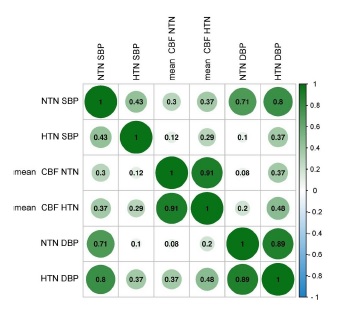Evaluation of the correlation between cerebral hemodynamics and blood pressure by comparative analysis of variation in cerebral blood flow in hypertensive versus normotensive individuals: A systematic review and meta-analysis
DOI:
https://doi.org/10.17305/bb.2024.10230Keywords:
Cerebral blood flow (CBF), hypertension, systolic blood pressure (SBD), diastolic blood pressure (DBP), normotension, cardiovascular risk factors, cerebral haemodynamic, systematic review, meta-analysisAbstract
Current understanding of the cerebral vascular response to variations in blood pressure (BP) among individuals with hypertension is limited. The aim of this meta-analysis was to determine the correlation between hypertension, risk of stroke, and cerebral blood flow (CBF). We reviewed studies published between 2000 and 2023 from PubMed, Google Scholar, and Science Direct that compared mean CBF in normotensive (NTN) and hypertensive (HTN) patients. A random effects model was used to construct the risk ratio (RR), 95% confidence interval (CI), forest plot, and inverse variance weighting. Additionally, a mixed-effects meta-regression was employed to examine the impact of study-specific patient variables. This meta-analysis included eight prospective cross-sectional studies published from 2002 to 2023. It revealed a significant average difference in the standard mean CBF of −0.45 (95% CI −0.60 to −0.30, I2 = 69%, P < 0.00001), distinguishing NTN from HTN subjects. A RR of 0.90 (95% CI 0.63 to 1.30, I2 = 89%, P = 0.04) indicated a significant decrease in CBF among individuals with hypertension. We found a statistically significant relationship between changes in diastolic and systolic BPs and the mean CBF (R −0.81, P = 0.001 and R = −0.90, P = 0.005, respectively). Our research demonstrates a strong relationship between elevated BP and reduced CBF, with hypertension reducing CBF compared to NTN individuals, by increasing cerebrovascular resistance.
Citations
Downloads

Downloads
Published
Data Availability Statement
Upon reasonable request, the corresponding author will provide access to the requested information.
Issue
Section
Categories
License
Copyright (c) 2024 Lei Yang, Hong Du, Xuejing Zhang, Dongliang Zhang, Xianhui Su, Zongrong Qiao, Bulang Gao

This work is licensed under a Creative Commons Attribution 4.0 International License.









